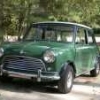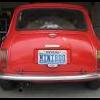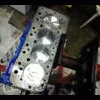
Dual Carb Tuning Question
#1

Posted 04 April 2007 - 04:34 PM
Succinctly the process goes as follows:
1) Let the engine idle to reach operating temperature before making adjustments.
2) Make sure both idle adjusting screws are contacting their stops, then disconnect the linkages between the carbs.
3) Run the jet nuts in until the jet tube contacts the piston, then back the nuts out two full turns.
4) Start the engine and adjust the idle screws (on both carbs) to reach perhaps 800 RPM.
5) Start with the back carb... run its idle screw in to raise the RPM up to 1000, then slacken the front carb idle screw until the RPM drop back to 800. Keep raising the rear carb's idle setting and lowering the front one until the front carb butterfly is effectively closed and you're running on the back carb alone.
6) Adjust the mixture on the back carb per the normal Haynes procedure for single carbs.
7) Reverse the idle adjustment settings until you're running on just the front carb and set its mixture per Haynes.
8) With both jets adjusted, adjust the idle screws to achieve the desired idle RPM and to achieve balanced air flow... then lock the throttle linkage in place per Haynes.
9) Set the high-speed (choke)
Have any of you ever tried anything like this where you effectively are tuning one carb's mixture at a time? It makes sense to me but I think it odd that it was not in any of the tuning manuals I've read. What do you think?
#2

Posted 05 April 2007 - 12:56 AM
I asked this question on another forum to see if they'd heard of it. I got lots of people quoting the Haynes manual in their replies and some who dismissed it outright. However, their arguments for why this wouldn't work don't wash. Only one guy on the other forum reported that he had heard of this procedure and he went on to say that an old professional MG mechanic taught him the method.
I'd still like comments about this from any of you here who have anything to say pro or con about this tuning method.
#3

Posted 05 April 2007 - 04:06 AM
basically tuning one at a time and finding the middle ground between the two.
#4

Posted 05 April 2007 - 07:44 AM
Edited by DJH MINI MOTORSPORT, 05 April 2007 - 07:44 AM.
#5

Posted 05 April 2007 - 08:19 AM
#6

Posted 05 April 2007 - 12:24 PM
DJH, this isn't an air flow balancing technique, this is a jet setting technique. You'd still have to balance the air flow after setting each carb's jet.
I posted this on another forum and the arguments against the procedure were not well reasoned. Let's take a succinct look at the carb fundamentals. Air passing through the venturi causes low pressure that is routed to the top side of the carb piston causing it to "lift" the needle out of the jet. A properly matched needle and spring in a properly adjusted jet supposedly deliver the proper air/fuel mix through the entire RPM range. Thus, for any given air flow, the needle lifts the proper amount to maintain the correct air/flow ratio. This implies that by blocking one carb off and running all the air through the other carb, the needle is raised higher in the working carb BUT (when properly set) would still be delivering the correct amount of fuel for THAT air flow to maintain the correct air/fuel ratio. Basically the carb is set to match the fuel delivery to the air flow for any given air flow.
Think of this as if you had a single, small HS2 supplying all four cylinders. You'd adjust the jet just like in the Haynes manual. Then, take that carb off and install a second one and repeat the procedure. Each carb's jet would be set to give the right mix for that engine... you'd just be connecting those independently set carbs to a common manifold when you're done. Obviously the idle speed settings would have to be adjusted when they're joined... but the jets should be set to deliever the proper mix.
I'd never heard of the process before but the more I think about it the more feasible it sounds. I may try it just to see what happens. When and if I do I'll report back... whether my results are good or bad.
#7

Posted 05 April 2007 - 01:12 PM
someone correct me if im wrong
#8

Posted 24 March 2008 - 03:02 AM
On another forum I frequent a poster suggested a dual carb tuning method that I've never seen listed in the manuals. I want to know if any of you have heard of or used this method and what your general comments about it are. (This regards dual HS2 carbs but probably applies to others).
Succinctly the process goes as follows:
1) Let the engine idle to reach operating temperature before making adjustments.
2) Make sure both idle adjusting screws are contacting their stops, then disconnect the linkages between the carbs.
3) Run the jet nuts in until the jet tube contacts the piston, then back the nuts out two full turns.
4) Start the engine and adjust the idle screws (on both carbs) to reach perhaps 800 RPM.
5) Start with the back carb... run its idle screw in to raise the RPM up to 1000, then slacken the front carb idle screw until the RPM drop back to 800. Keep raising the rear carb's idle setting and lowering the front one until the front carb butterfly is effectively closed and you're running on the back carb alone.
6) Adjust the mixture on the back carb per the normal Haynes procedure for single carbs.
7) Reverse the idle adjustment settings until you're running on just the front carb and set its mixture per Haynes.
8) With both jets adjusted, adjust the idle screws to achieve the desired idle RPM and to achieve balanced air flow... then lock the throttle linkage in place per Haynes.
9) Set the high-speed (choke)
Have any of you ever tried anything like this where you effectively are tuning one carb's mixture at a time? It makes sense to me but I think it odd that it was not in any of the tuning manuals I've read. What do you think?
sorry to drag this up! Sounds really interesting, effectively isolating one carb at a time, and then setting each one individually. I had often thought of doing something similar although the issue of the balance pipe always worried me, - even though it is probably has little effect on the mixture settings.
1 user(s) are reading this topic
0 members, 1 guests, 0 anonymous users


















